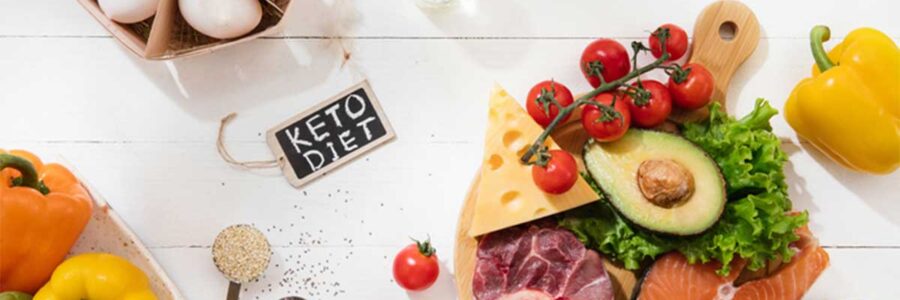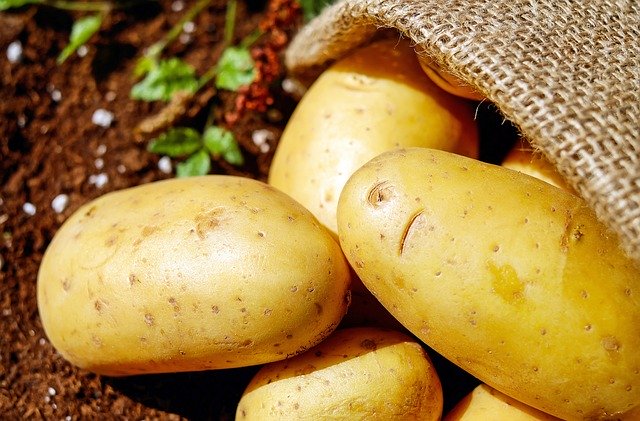Many people have trouble actually reaching ketosis, sticking to it, and losing weight on the keto diet. If that’s your case, consider today your lucky day! We rounded up the best keto tips and tricks out there to help you make the most out of keto and start losing weight in a sustainable, safe, and effective manner as soon as possible.
Tips for Getting into Ketosis
To reach a state of nutritional ketosis, the general rule is to stick to a ketogenic macronutrient intake ratio. This means you should get no more than 5-10% of your daily calories from carbohydrates, contrary to the 45-65% in a standard healthy diet.(1,2) The remaining 30-35% of calories should come from protein, and 55-65% from dietary fat.(3) Sounds easy? Well, here are some useful tips to help you out even further!
1. Watch out for hidden carbs
Contrary to what some people think, carbs aren’t limited to just table sugar. Studies indicate that the top 10 food groups that contribute to carbohydrate intake are:(4)
- Bread
- Fruit
- Dairy
- Sweet pastry
- Potato
- Sugar and jam
- Pasta and rice
- Vegetables and legumes
- Crispbread
- Juices (fruit and vegetable)
As you can see, plain sugar is just one of the many top sources of carbohydrate in the average diet, and you should stay alert for other food groups.
Also, remember that there are many synonyms for sugar. Some of them may sound like no big deal but will prevent you from reaching ketosis even if you take just a little bit of them:
- High-fructose corn syrup
- Agave nectar
- Evaporated cane juice
- Molasses
- Fruit juice concentrate
- Sucanat
Avoid the items in this short list at all costs!
2. Drink more coffee
A study from 2017 reported that caffeine for breakfast significantly increases the production of ketones in the body in a dose-dependent manner.(5) Specifically, taking 2.5 mg of caffeine for each kilogram of body weight led to an 88% boost in ketones and 5 mg/kg resulted in a 118% increase.
For a person weighing 70 kg (154 pounds), 2.5 mg of caffeine for each kilogram of body weight amounts to 175 mg of caffeine total. That’s a bit more than the dose in a 12-ounce Americano coffee, just so you know.(6) However, even if you drink less coffee than that, you’ll still experience a boost in ketone bodies since the effect is dose-dependent!
3. Try intermittent fasting
Intermittent fasting is a meal-timing approach in which periods of voluntary food restriction are cycled with non-fasting periods. The simplest (and easiest!) form of intermittent fasting is skipping either your first or last meal throughout the day. Together with your sleeping time at night, this should be enough to get you into mild ketosis by the end of this daily fast.(7)
Short-term fasting is an easy and straightforward way to initiate ketosis, but make sure to stick to a ketogenic macronutrient intake ratio when you start eating. After all, you won’t be able to stay in ketosis if you break your fast with a good dose of carbohydrates.
4. Avoid chronic or significant stress
Of course, some degree of stress is nothing to worry about. Chronic or intense stress, on the other hand, may lead to elevated cortisol levels, and that’s where the real problem starts.
Cortisol is a stress hormone with a wide range of functions aimed to increase your chances of survival in extreme conditions. One of these effects is that cortisol increases blood glucose levels through several pathways:
- It stimulates gluconeogenesis in the liver (glucose production from non-glucose sources(8)
- It increases glucagon synthesis in the pancreas.(8) Glucagon is a hormone that stimulates the conversion of stored glycogen into glucose.
- It reduces the production of insulin, the hormone that would normally reduce blood glucose levels.(9)
Long story short, if you’re stressed and your cortisol levels are soaring, you’ll have a hard time reaching ketosis due to your high blood glucose levels.
5. Exercise more
The body enters a state of nutritional ketosis only after it depletes most of its glycogen stores.(3)
To speed up this process, an easy way is to engage in intense physical activity. Studies indicate that glycogen is the primary source of energy during vigorous exercise, even when the activity itself is brief.(10,11)
For example, doing ten quick 30-second sprints with a short period of recovery between them is already enough to significantly deplete the glycogen stores in the muscles.(11)
Tips for Making Keto Dieting Manageable
The keto diet is one of the strictest diets out there, so if you’re used to eating a lot of carbs, going keto can be extremely hard. Don’t worry, though! We’ve got a few keto tips to help you out in this matter too.
1. Stay hydrated at all times
Dehydration is a common issue on the keto diet, especially when you’re just starting out. This is because one of the steps on the path to nutritional ketosis is to burn through the body’s glycogen—a form of stored glucose.(1)
Studies estimate that each gram of glycogen is bound to about 3 g of water.(12) When glycogen is broken down, all of this water gets unbound and has to be excreted, and that’s why you’ll likely experience a significant increase in urination. If not restored promptly, this loss of fluid will impair your motivation and make you feel constantly tired, so make sure to drink enough water every day.
2. Buy and cook in bulk
The keto diet is merciless in its restrictions: your daily carbohydrate and fat intake has to stay in strictly defined limits if you want to reach and stay in ketosis. This essential keto requirement is hard to follow if you don’t plan ahead, buy your ingredients in bulk, and cook your meals beforehand.
Calculate your personal macronutrient goals and write down a meal plan for the week. Cook everything on Saturday on Sunday, then freeze your meals for future use. When the time comes, you’ll be grateful to yourself for this opportunity to stay in ketosis even when you feel too tired or lazy to cook something fresh!
3. Find a keto-friendly sugar substitute
For many people with a sweet tooth, the hardest part of going keto is in avoiding any form of sugar, including sucrose (table sugar) and fructose (the main sugar in fruits).
There is no working around this requirement, so a useful keto tip is to find a keto-friendly sugar substitute that would work for you. Look for a compound with a glycemic index (GI) as close as possible to zero, as these are the sweeteners that won’t affect your blood glucose at all. The lower the GI, the safer a certain ingredient is during the keto diet. Here’s a quick list of the GI of some common sweeteners to help you get started:(13)
- Aspartame* (brand names include Equal, Sugar Twin, and Nutrasweet) – 0
- Saccharin* (Sweet and Low, Necta Sweet, Sweet Twin) – 0
- Sucralose* (Splenda) – 0 *this is not a recommended sweetener
- Erythritol* – 0
- Stevia – 0
- Isomalt* – 2
- Sorbitol* – 9
- Xylitol* – 7-13
*We do not recommend using any of these zero-calorie sweeteners, other than organic, whole leaf stevia.
For comparison, table sugar has a glycemic index of 61-65 while glucose features a GI of 100.
4. Stick to simple but tasty meals
Complex tasks, goals, and processes are always accompanied by significant resistance and require a lot of willpower to be done. For sustainable success with the keto diet, make simple and easy recipes the basis of your everyday diet and leave the fancy meals for fancy occasions or weekends.
In other words, you’ll be much more likely to follow through the keto principles if your meal plan consists of:
- Fried eggs and bacon
- Steamed salmon seasoned with salt, pepper, and lemon juice
- Baked chicken breasts topped with cheese
Instead of:
- Almond-crusted wild trout with steamed Swiss chard on the side
- Chicken breasts stuffed with artichoke and spinach
- Baked eggs in prosciutto baskets
Remember: the easier something is to cook, the more likely you’ll be to cook it. Yes, even on meal prep days.
5. Use fat bombs to get enough dietary fat
On the keto diet, at least 55 to 60% of your daily calories should come from dietary fat. Some experts suggest going for as much as 70%, even.(3) For many beginners, this is no easy feat.
A simple solution is to prepare a few batches of so-called fat bombs for when you see you’re falling behind your daily fat goal. Fat bombs are sweet or savory bite-sized snacks that can pack up to 20 g of fat per serving at the expense of just a few net carbs.
Additionally, fat bombs are an awesome keto-friendly snack to have at hand when that unexpected sugar cravings kick in. Just don’t eat too many of them, as this could easily lead to a significant calorie surplus and impaired weight loss as a result.
Tips for Losing Weight on Keto
Losing weight on keto is pretty straightforward: all you have to do is reach ketosis to trigger the process. In some cases, however, it seems that the weight just won’t go away—even though you’ve confirmed you’re in stable ketosis. Here are a few tips to help you fix that!
1. Limit your daily calorie intake
Keto or not, it’s practically impossible to lose weight while bingeing on calories.
According to the National Institutes of Health, you should aim for a 500 to 1000 daily calorie deficit for a safe and sustained weight loss of 1 to 2 pounds per week.(14) This recommendation, however, is aimed to be effective for traditional carbohydrate-fueled diets.
On keto, start without any calorie deficit whatsoever and stick to it for a few weeks to see how your body responds. Reaching ketosis should initiate weight loss through the burning of previously stored fat without calorie deficit. If you reach a keto plateau and stop losing weight, try cutting your calories by 15-30% for about a week.
2. Don’t limit your daily calorie intake TOO much
This issue is rather rare on keto due to the caloric density of all fats, but it’s still real. Essentially, if your daily calorie intake is too low, your body slows down its metabolism to compensate for the lacking influx of energy.(15)
This is an adaptive process that’s aimed to ensure survival during times of food scarcity or downright starvation. By inhibiting its metabolism, the body is able to preserve energy without breaking down too much of its lean mass.
Long story short, try to not cut your daily calories by more than 30-35% for a sustained and safe weight loss.
3. Get enough sleep every night
Ghrelin is a hormone produced in the gastrointestinal tract that plays a major role in triggering the feeling of hunger. Besides increasing appetite, ghrelin is known to promote fat deposition and growth hormone release.(16) Why is this important for your success on the keto diet? Well, studies indicate that a single night of poor sleep can increase ghrelin levels by 10-32%.(17)
To feel less hungry and prevent ghrelin from promoting fat deposition, do your best to sleep well every night!
4. Try taking exogenous ketones
Hunger bouts and sugar cravings are some of the most common reasons why people have trouble sticking to any diet and losing weight on it. In most cases, dieters experience a significant drop in appetite and cravings once they reach a certain level of ketosis, but sometimes you just need some extra help to get things going.
In this matter, exogenous ketones can be extremely helpful. Both animal and human studies reported that exogenous ketone bodies directly reduce appetite, lower ghrelin levels (the hunger hormone), and ultimately lead to eating less.(18, 19)
5. Fix your leptin resistance
Leptin is a hormone secreted by the body’s fatty tissue that reduces appetite and serves as a counter-balance to the hunger hormone ghrelin.(20) Additionally, leptin promotes the burning of fat (lipolysis) and inhibits the formation of new fat (lipogenesis) as a way to regulate its own levels.(21)
But what happens if you’re leptin-resistant? In this case, your body produces enough leptin, but the brain doesn’t respond to its action. As a result, your appetite doesn’t go down and your body fat levels stall.(22)
Common causes of leptin resistance include chronic inflammation, abnormally high leptin levels, overeating, and stress(23, 24, 25). Do your best to fix these issues, and your body weight is likely to go down once the resistance is reduced!
Other Keto Diet Tips
Well, now you’re in ketosis, doing well, and losing weight consistently. What next? How can you further enhance your success on the keto diet? Here are a few ideas!
1. Use a specialized calorie & macronutrient tracking app
Studies report that self-monitoring of your food intake can significantly boost your adherence to any given diet—and eventually promote weight loss.(26)
This effect is probably a variation of what’s known as the Pearson’s Law, named after English mathematician Karl Pearson: ”That which is measured, improves.”
Essentially, any kind of tracking and measuring of your performance on any diet, including keto, makes you much more likely to follow through all of its principles. Of course, the most convenient and easy way of doing that is to use a tracking app like MyFitnessPal.
By the way, guess how you can speed up this improvement? The second part of Pearson’s Law states: ”That which is measured and reported, improves exponentially.” Find an accountability buddy or make your progress public (through social media, for example), and you’ll soon see your performance skyrocket.
2. Join a support group with fellow keto dieters
If you want to go fast, go alone. If you want to fo far, go together.
Joining a keto-themed group can have a whole lot of different benefits for you and make it so much easier to reach your weight loss goals.
- Share keto recipes and cooking tips
- Discuss common worries and troubles
- Support each other through the initial period of keto-adaptation
- Share success stories and cheer for each other’s progress
3. Tailor your keto diet to your dietary preferences
This isn’t just common sense, but a weight loss strategy that has been scientifically confirmed to improve dieting adherence.(26)
The keto diet is a set of macronutrient recommendations, not a specific list of foods to eat or avoid. To enhance your keto-performance and satisfaction, find foods and meals that are both keto-friendly AND pleasant to you personally.
There’s little point in stuffing yourself with ingredients you don’t like just to reach a certain weight goal. For the most part, a diet has to be delicious to be effective.
4. Make your environment keto-friendly
Most people have no idea how much their environment affects their day-to-day choices. More often than not, your behavior is a direct result of the things and people that surround you.
For example, if you have a bowl of cookies sitting on your kitchen table, there’s a good chance you’ll pick one throughout the day when you’ll be on auto-pilot mode. Or two. Or a dozen.
If the restaurant you visit with your friends every other day has no keto meals on their menu, you’ll either break your diet or have to endure the hunger while everyone around enjoys themselves.
An easy solution to this dilemma is to plan ahead and make your environment as much keto-friendly as possible:
- Clear out your kitchen of carb-ridden foods and ingredients. Stack on keto-friendly snacks instead, like nuts or fat bombs.
- Check the menu of the restaurants you usually visit and see if they offer any keto meals. If they don’t, look for an alternative in your city.
- Discuss your keto diet with your friends and family, so that they’ll be aware of your restrictions and will be able to plan accordingly—for example, when choosing what to cook for a family gathering.
5. Know what to expect (and how to react)
Many people experience a set of unpleasant symptoms during their adaptation to the keto diet. Constipation, headache, muscle cramps, general weakness, and bad breath (sometimes called the keto breath) are among the most common ones. Collectively, these symptoms are known as the keto-flu and are caused by:(27)
- Significant loss of sodium, potassium, and water during the first week of going keto
- Decreased insulin levels due to lower blood glucose levels
Although extremely unpleasant, these symptoms aren’t dangerous for most people without any pre-existing health conditions.
Drink plenty of water, keep an eye on your sodium and potassium intake, and brace yourself for a while. As a rule, most people feel much better by day 4 of their keto-adaptation. Additionally, you can try taking exogenous ketones or medium-chain triglyceride (MCT) oil, as these two were confirmed to somewhat mitigate the symptoms of keto flu.
And, of course, never hesitate to get in touch with your physician if you feel these symptoms are getting too intense or persist for longer than 5-7 days. If that’s the case, there’s a chance the keto diet just isn’t for you.
References:
- https://www.ncbi.nlm.nih.gov/books/NBK499830/
- https://www.ncbi.nlm.nih.gov/pmc/articles/PMC4224210/
- https://www.ncbi.nlm.nih.gov/books/NBK499830/
- https://www.ncbi.nlm.nih.gov/pubmed/12639227/
- https://www.ncbi.nlm.nih.gov/m/pubmed/28177691/
- https://www.caffeineinformer.com/caffeine-content/caffe-americano
- https://www.ncbi.nlm.nih.gov/pmc/articles/PMC4042085/
- https://www.ncbi.nlm.nih.gov/books/NBK538239/
- https://www.ncbi.nlm.nih.gov/pmc/articles/PMC5115704/
- https://www.frontiersin.org/articles/10.3389/fphys.2011.00112/full
- https://www.ncbi.nlm.nih.gov/pmc/articles/PMC6019055/
- https://www.ncbi.nlm.nih.gov/pubmed/25911631
- https://www.ncbi.nlm.nih.gov/pmc/articles/PMC3982014/
- https://www.nhlbi.nih.gov/health/educational/lose_wt/recommen.htm
- https://www.ncbi.nlm.nih.gov/pubmed/11430776
- https://www.ncbi.nlm.nih.gov/pubmed/24100676
- https://www.ncbi.nlm.nih.gov/pubmed/18564298
- https://www.ncbi.nlm.nih.gov/pmc/articles/PMC5813183/
- – https://www.ncbi.nlm.nih.gov/pmc/articles/PMC6578424/
- https://www.ncbi.nlm.nih.gov/pmc/articles/PMC6354688/
- https://www.sciencedirect.com/science/article/pii/S0925443913001634
- https://onlinelibrary.wiley.com/doi/full/10.1038/oby.2006.319
- https://www.ncbi.nlm.nih.gov/pmc/articles/PMC3281561/
- https://www.ncbi.nlm.nih.gov/pmc/articles/PMC5605162/
- https://www.ncbi.nlm.nih.gov/pmc/articles/PMC3409346/
- https://www.ncbi.nlm.nih.gov/pmc/articles/PMC5618052/
- https://www.ncbi.nlm.nih.gov/pmc/articles/PMC5858534/





